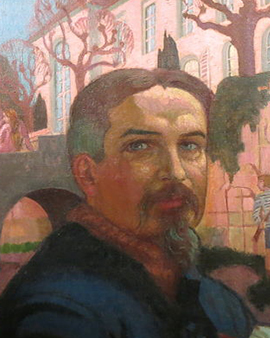"It should be remembered that before a picture is a war horse, a naked woman or any anecdote, it is essentially an ordinary surface covered with colours arranged in a certain way". At the end of the 19th century, this was an outrageous statement by a young painter only twenty years old and a rejection of the conventional painting of art academies.
This young man, living in a suburb of Paris, was called Maurice Denis and was influenced early on by Gauguin and his students. Their hallmark was the use of pure, radiant colors and a clear formal language. Around 1888 he founded the group "Les Nabis" with like-minded, rebellious artists such as Pierre Bonnard and Paul Sérusier. He was regarded as the theoretician of the group and published various articles on his view of art in important contemporary publications. As far as non-European influences are concerned, the Nabis were particularly interested in Japanese woodblock prints.
A typical picture of him is the painting "Sunspots on the Terrace", which shows a female figure on a surface surrounded by trees. With its strongly reduced forms, the figure is hardly recognizable as a woman, and almost exclusively held in complementary colors, this painting in its radical reduction already refers to the coming avant-garde of the 20th century.
×





 - (MeisterDrucke-130528).jpg)
 - (MeisterDrucke-130528).jpg)
.jpg)
.jpg)
.jpg)
.jpg)
.jpg)
.jpg)
.jpg)
.jpg)
.jpg)
.jpg)
.jpg)
.jpg)
.jpg)
.jpg)
.jpg)
.jpg)
.jpg)
.jpg)
.jpg)
.jpg)
.jpg)
.jpg)
.jpg)
.jpg)
.jpg)
.jpg)
.jpg)
.jpg)
.jpg)
.jpg)
_Collection_privee_-_(MeisterDrucke-1651160).jpg)
_Collection_privee_-_(MeisterDrucke-1651160).jpg)
.jpg)
.jpg)
.jpg)
.jpg)
.jpg)
.jpg)
.jpg)
.jpg)
.jpg)
.jpg)
.jpg)
.jpg)
.jpg)
.jpg)
.jpg)
.jpg)
.jpg)
.jpg)
.jpg)
.jpg)
.jpg)
.jpg)
 1906 - (MeisterDrucke-136052).jpg)
 1906 - (MeisterDrucke-136052).jpg)
.jpg)
.jpg)
.jpg)
.jpg)
.jpg)
.jpg)
_Peinture_de_-_(MeisterDrucke-1324939).jpg)
_Peinture_de_-_(MeisterDrucke-1324939).jpg)
.jpg)
.jpg)
.jpg)
.jpg)
.jpg)
.jpg)
.jpg)
.jpg)
.jpg)
.jpg)
.jpg)
.jpg)
 1918 - (MeisterDrucke-198483).jpg)
 1918 - (MeisterDrucke-198483).jpg)
.jpg)
.jpg)
.jpg)
.jpg)
 - (MeisterDrucke-143216).jpg)
 - (MeisterDrucke-143216).jpg)
 - (MeisterDrucke-124351).jpg)
 - (MeisterDrucke-124351).jpg)
.jpg)
.jpg)
.jpg)
.jpg)
.jpg)
.jpg)
.jpg)
.jpg)
.jpg)
.jpg)
.jpg)
.jpg)
.jpg)
.jpg)
.jpg)
.jpg)
.jpg)
.jpg)
.jpg)
.jpg)
_-_(MeisterDrucke-142677).jpg)
_-_(MeisterDrucke-142677).jpg)
.jpg)
.jpg)
.jpg)
.jpg)
.jpg)
.jpg)
.jpg)
.jpg)
.jpg)
.jpg)
 at Cagnes 1913 (pencil wc on paper) - (MeisterDrucke-120579).jpg)
 at Cagnes 1913 (pencil wc on paper) - (MeisterDrucke-120579).jpg)
.jpg)
.jpg)
.jpg)
.jpg)
.jpg)
.jpg)
.jpg)
.jpg)
.jpg)
.jpg)
.jpg)
.jpg)
.jpg)
.jpg)
_-_(MeisterDrucke-1653738).jpg)
_-_(MeisterDrucke-1653738).jpg)
.jpg)
.jpg)
_20th_century_(oil_on_canvas)_-_(MeisterDrucke-1003175).jpg)
_20th_century_(oil_on_canvas)_-_(MeisterDrucke-1003175).jpg)
.jpg)
.jpg)
.jpg)
.jpg)
.jpg)
.jpg)
.jpg)
.jpg)
_-_(MeisterDrucke-1325834).jpg)
_-_(MeisterDrucke-1325834).jpg)
.jpg)
.jpg)
 - (MeisterDrucke-139636).jpg)
 - (MeisterDrucke-139636).jpg)
.jpg)
.jpg)
 - (MeisterDrucke-137748).jpg)
 - (MeisterDrucke-137748).jpg)
.jpg)
.jpg)
.jpg)
.jpg)
.jpg)
.jpg)
.jpg)
.jpg)
.jpg)
.jpg)
.jpg)
.jpg)
.jpg)
.jpg)
.jpg)
.jpg)
.jpg)
.jpg)
_1900_(oil_on_canvas)_-_(MeisterDrucke-1000400).jpg)
_1900_(oil_on_canvas)_-_(MeisterDrucke-1000400).jpg)
.jpg)
.jpg)
.jpg)
.jpg)
.jpg)
.jpg)
.jpg)
.jpg)
.jpg)
.jpg)
.jpg)
.jpg)
_-_(MeisterDrucke-1122207).jpg)
_-_(MeisterDrucke-1122207).jpg)
.jpg)
.jpg)
.jpg)
.jpg)
.jpg)
.jpg)






